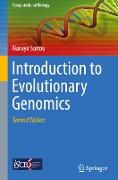- Start
- Introduction to Evolutionary Genomics
Introduction to Evolutionary Genomics
Angebote / Angebote:
This authoritative textbook/reference presents a comprehensive introduction to the field of evolutionary genomics. The opening chapters describe the fundamental concepts in molecular biology and genome evolution for readers without any prior background in this area. This is followed by a detailed examination of genome evolution in various different groups of organisms. The text then concludes with a review of practical methods essential to researchers in the field.This updated and revised new edition also features historical perspectives on contributions to evolutionary genomics from related fields such as molecular evolution, genetics, and numerical taxonomy.Topics and features:Introduces the basics of molecular biology, covering protein structure and diversity, as well as DNA replication, transcription, and translationExamines the phylogenetic relationships of DNA sequences, and the processes of mutation, neutral evolution, and natural selectionPresents a brief evolutionary history of life, surveying the key features of the genomes of prokaryotes, eukaryotes, viruses and phages, vertebrates, and humansReviews the various biological “omic” databases, and discusses the analysis of homologous nucleotide and amino acid sequencesProvides an overview of the experimental sequencing of genomes and transcriptomes, and the construction of phylogenetic treesDescribes methods for estimating of evolutionary distances, and performing studies of population geneticsSupplies additional supporting material at an associated websiteServing as an indispensable textbook for graduate and advanced undergraduate courses on evolutionary genomics, this accessible overview will also prove invaluable to researchers from both computer science and the biological sciences seeking a primer on the field.Dr. Naruya Saitou is a Professor in the Division of Population Genetics at the National Institute of Genetics, and a Professor in the Department of Genetics at the Graduate University for Advanced Studies, Mishima, Japan. He is also a Professor in the Department of Biological Sciences at the University of Tokyo, Japan.
Folgt in ca. 10 Arbeitstagen
